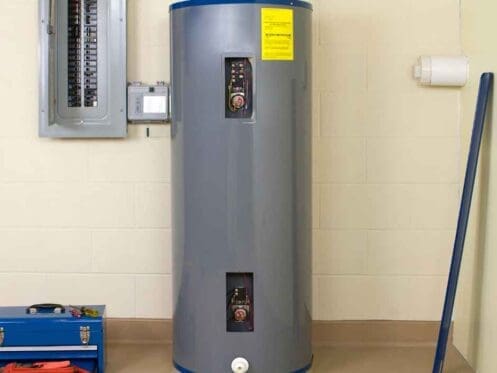The ideal temperature for your water heater plays a crucial role in both comfort and safety. Setting your water heater temperature correctly not only ensures a steady supply of warm water but also helps prevent scalding accidents, conserve energy, and prolong the life of your water heater. So, what temperature should a water heater be set at? Here, we’ll explore recommended water heater settings, safety guidelines, and how regular maintenance can help keep your hot water heater running smoothly.
Recommended Temperature Settings for a Water Heater
The U.S. Department of Energy suggests setting water heaters at 120°F (49°C) to balance safety, energy efficiency, and comfort. At this temperature, you reduce the risk of scalding injuries while maintaining water warm enough for daily needs like bathing, cleaning, and cooking.
However, some households may benefit from setting their water heater a bit higher. For example, if you have a dishwasher that doesn’t preheat water, or if someone in your home has a compromised immune system, increasing the temperature to 140°F (60°C) may be necessary to ensure better sanitization and protection against bacteria like Legionella, which can survive in temperatures below 120°F.
Why Water Heater Temperature Matters
Adjusting the temperature settings of a water heater impacts several aspects of your home life, from safety to energy costs. Here’s why finding the right setting matters:
- Safety: Keeping water heater settings too high increases the risk of scalding injuries, particularly for young children or elderly family members. Water heated above 140°F can cause burns within seconds. At 120°F, the risk of accidental burns is significantly reduced, making it a safer option for most households.
- Energy Savings: Lowering your water heater temperature can lead to substantial energy savings. According to the U.S. Department of Energy, reducing the temperature by just 10°F can save up to 5% on water heating costs. Given that water heating accounts for around 18% of a home’s energy use, optimizing your hot water heater settings can make a noticeable difference on your utility bills.
- Water Heater Longevity: Maintaining moderate water heater temperature settings can extend the life of your unit. High temperatures cause sediment buildup more quickly, particularly in areas with hard water. Over time, sediment can damage the tank, heating elements, and even lead to leaks, reducing the overall lifespan of your water heater. By setting your water heater to 120°F, you can slow sediment accumulation, resulting in less maintenance and a longer-lasting appliance.
Steps for Adjusting Your Water Heater Temperature
Knowing how to adjust your water heater’s temperature settings is helpful if you need to make changes. Here are the steps for both gas and electric models:
For Electric Water Heaters:
- Turn off the Power: Switch off the circuit breaker to the water heater for safety.
- Access the Temperature Dial: Remove the access panel on the side of the water heater tank, then remove any insulation covering the thermostat.
- Adjust the Temperature: Using a flathead screwdriver, turn the thermostat dial to your desired temperature setting.
- Reassemble: Replace the insulation and access panel, and turn the power back on.
For Gas Water Heaters:
- Locate the Dial: The temperature control dial is usually located at the base of the water heater near the gas valve.
- Adjust the Temperature: Turn the dial to the desired temperature. Most dials have markings such as “Low,” “Hot,” and “Very Hot.” Consult your user manual for temperature equivalents.
- Monitor: Give the water heater about three hours to adjust, then check the temperature of your hot water at the tap.
Signs Your Water Heater Temperature Needs Adjustment
Sometimes it’s necessary to adjust your water heater temperature to suit seasonal or usage needs. Here are a few signs that indicate a change might be beneficial:
- Inconsistent Water Temperature: If you’re experiencing water that fluctuates between hot and cold, it might be due to a thermostat issue or an aging heating element. Adjusting the settings can sometimes improve consistency, but a professional inspection may be needed.
- Frequent Scalding Incidents: If your water feels too hot, it’s a sign the temperature may be set too high. Lowering it can prevent accidental burns.
- Higher Energy Bills: A sudden increase in energy costs may point to inefficient water heating, especially if your thermostat is set too high. Reducing the temperature can help lower monthly bills.
- Cold Showers: If your hot water runs out quickly, it could mean the setting is too low or that sediment buildup is causing issues. Increasing the temperature may help, but regular water heater maintenance is also recommended.
Water Heater Maintenance Tips for Optimal Performance
Regular water heater maintenance ensures that your system runs efficiently and maintains the right temperature setting for years. Here’s a basic maintenance checklist for homeowners:
- Flush the Tank Annually: Sediment buildup inside the tank can affect water temperature and heating efficiency. Flushing your water heater once a year removes sediment and helps extend the life of your unit.
- Inspect the Anode Rod: This rod helps prevent corrosion within the tank. Inspecting it every 1-2 years and replacing it as needed can protect the tank from rust.
- Test the Temperature and Pressure Relief Valve: This valve releases pressure if the water temperature or pressure becomes too high, which can prevent damage to the tank. Testing it annually can ensure it functions correctly.
- Check the Thermostat Settings: Occasionally check your thermostat to ensure it’s set to your preferred temperature and isn’t fluctuating.
Keeping up with these maintenance tasks helps you get the best performance from your water heater and ensures you have a reliable supply of hot water year-round.
Choosing the Best Temperature Setting for Your Household
The best temperature setting ultimately depends on your household’s needs, energy goals, and safety concerns. For most households, 120°F provides a balance of warmth, energy efficiency, and safety. However, if your home requires a higher temperature setting due to health considerations or specific appliances, 140°F is also a suitable option—just exercise caution and monitor usage to avoid scalding.
If you’re uncertain about your water heater temperature settings or concerned about energy costs, consulting a professional can help. Charleston Heating & Air offers expert guidance on optimizing your hot water heater to meet your home’s unique needs.
Ensure Optimal Performance with Water Heater Maintenance
Setting your water heater to the correct temperature can improve safety, reduce energy costs, and extend the life of your system. From preventing scalding to saving on utility bills, the right temperature setting is crucial for maintaining a comfortable home.
Whether you’re looking to adjust your water heater temperature or need routine maintenance, Charleston Heating & Air is here to help. Contact Charleston Heating & Air for all your water heater maintenance needs and ensure your hot water heater is running at peak efficiency.

